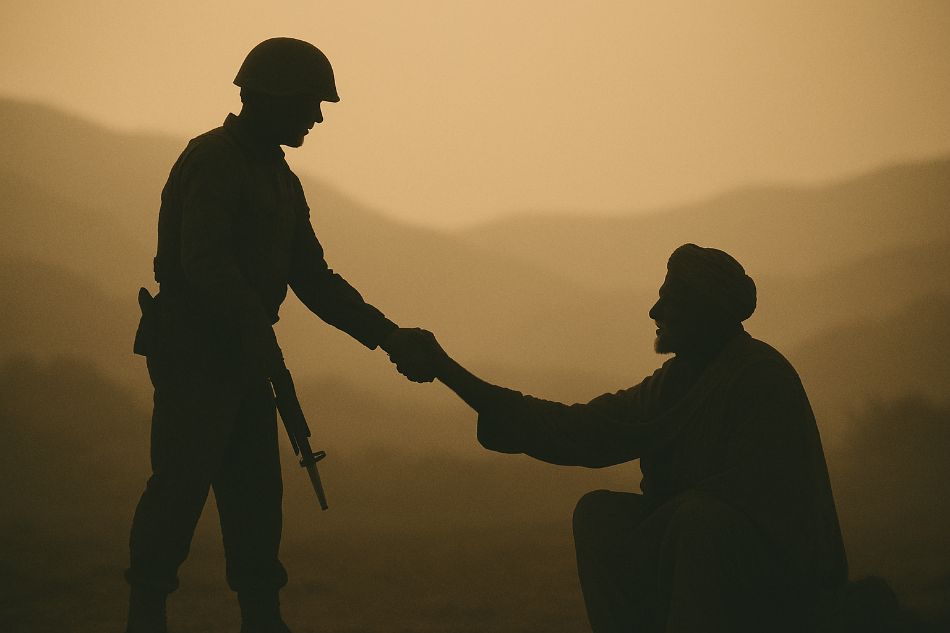“To fight and conquer in all our battles is not supreme excellence; supreme excellence consists in breaking the enemy’s resistance without fighting.” This classic dictum from Chinese military strategist Sun Tzu’s book The Art of War underscores the importance of strategic thinking and maneuvering — rather than using brute force — in achieving victory.
In counterinsurgency efforts, this strategy appears to be an essential guiding principle and a far more effective approach than the use of brute force in quelling unrest in a population. Heavy-handed approach further amplifies public resentment and prepares a breeding ground for insurgent outfits. When a state relies on brute force rather strategic thinking, it incurs intense public anger. Heavy-handed approaches often backfire because civilians inadvertently harmed by military operations tend to develop a negative perception of the government and sympathize with insurgent groups.
As a result, it provides an opportunity to insurgents to take advantage of the government’s offensive tactics and cultivate a strong relationship with the public. It leads to the erosion of the government’s legitimacy. When the government exerts pressure through overusing force and resorting to collective punishment, it creates a cycle of violence. Hence, it exacerbates the humanitarian crisis and undermines the government’s authority. When the reputation of the government suffers, it becomes increasingly challenging to combat the insurgency effectively.
In a conflict zone, the population is often divided into three segments: the majority, minority, and neutral populations. The majority population may be aligned with the government or the insurgent outfits, whereas the minority population may be opposed to the dominant group. But it is the neutral population that holds the key to winning the conflict. In the neutral population are those individuals who have not yet taken sides or are undecided about which group to support. This group may include civilians who are caught in the middle of the conflict, community leaders, influential individuals or ethnic and tribal chieftains who have not yet declared their allegiance. Of course, both the government and insurgents recognize the importance of winning over neutral populations, since their support can significantly tip the balance in favor of one side.
Today, the situation in Balochistan is a vivid illustration of how a government’s over-reliance on force and crackdown on peaceful protesters can shape the attitude of the neutral population towards insurgents. As the government uses a heavy-handed approach, it increases the likelihood of the neutral population being drawn towards the insurgents.
The primary reason the government has failed to counter insurgency in the province is its reliance on an enemy-centric approach. This approach has led the government to focus solely on eliminating the insurgents, while neglecting the critical element to narrow the space for militant outfits — the civil population. In counterinsurgency efforts, it is paramount that the government should chalk out a population-centric strategy.
A population-centric approach can help shrink the space for insurgents’ operations in a locality. When the government earns the support of the population, insurgents cannot receive any logistic support, intelligence and even shelter. To achieve this, a parallel policy strategy should be devised to focus on protecting the general populace, providing basic rights, addressing grievances and building trust. By adopting a population-centric approach, the government can shift focus from solely eliminating the insurgents to addressing the root causes of insurgency.
Since the government has failed to address the internal factors driving the insurgency, it has led to a focus on external and geopolitical factors. Even though the geo-strategic location of the province makes it a coveted geopolitical chessboard, external players can only exploit this position when the government neglects to address the province’s internal issues.
The focus on only geopolitical factors has resulted in a hard military-centric approach, which has only served to exacerbate the problem and build further grievances. The real issues fueling the insurgency remain unaddressed. It includes historical grievances, an uneven federal structure, a fragile and fragmented provincial polity, political manipulation, “installed” unpopular government, lack of genuine political representation, unmet basic necessities, development disparities, and poor governance.
By neglecting these internal factors, the government has created a vacuum that allows insurgents to exploit these grievances and recruit new members to build their manpower. A solely military-centric approach may even provide temporary security gain; however, it will not address the underlying drivers of the insurgency. To truly resolve the conflict and restore peace in the province, the government must adopt a more subtle approach that prioritizes addressing the root causes of the insurgency and providing for the basic needs and rights of the affected population in an inclusive manner.
For good or bad, the insurgency in Balochistan has challenged the traditional social order of the province, which was once characterized by feudalism, the sardari system, and gender inequality. The insurgency has weakened the grip of these traditional power structures, creating space for new social and political forces to emerge. The sardars, who once claimed to represent the people and wielded significant influence over the province’s political dynamics, no longer enjoy the same level of popular support.
This shift in public sentiment reflects a deeper social revolt against the existing system. People in Balochistan are increasingly demanding democracy, the rule of law, and the protection of their rights. The state can leverage this momentum by engaging with the Baloch Yakjehti Committee (BYC) to explore viable avenues for a multilayered dialogue with the civil society because it has far more public support than any traditional political party in the province.
Counterinsurgency efforts often fail because of the inability of governments to grasp the socio-cultural dynamics of the affected society. A notable example is the US military’s failure in Vietnam, which was driven by a combination of strategic, tactical, and operational shortcomings. The Viet Cong’s successful guerrilla warfare tactics — coupled with the US military’s conventional approach, cultural misunderstandings, inadequate intelligence, and overreliance on technology — ultimately led to a prolonged and bloody conflict. It highlights the importance of understanding the intricacies of insurgent movements and the local culture, lest counterinsurgency efforts falter and exacerbate the conflict.
On the other hand, the British campaign in Malaya (1948-1960) is often cited as a model of successful counterinsurgency, where a comprehensive approach incorporating military, economic, and social measures helped to defeat the communist insurgency. Similarly, the Philippine government’s efforts to counter the Hukbalahap insurgency (1942-1954) were successful due to a combination of military operations, social and economic reforms, and co-optation of insurgent leaders. Moreover, the Colombian government’s campaign against the FARC insurgency (2002-2016) also achieved significant success through a comprehensive approach incorporating both military operations and economic development.
The concept of counterinsurgency has evolved significantly over time, with pioneering military strategists recognizing the importance of addressing the root causes of insurgencies. The third Marquis of Santa Cruz de Marcenado, in his book Reflexiones Militares, emphasized the need for good governance and clemency towards the population. Santa Cruz’s ideas on counterinsurgency were well ahead of his time, advocating for winning the hearts and minds of the people rather than relying solely on military force. This approach has been reinforced by modern scholars, including John Mackinlay, who stresses in his book The Insurgent Archipelago: From Mao to Bin Laden the importance of understanding the social and cultural context of insurgency and the role of networks and relationships in sustaining insurgent movements.
To effectively counter modern insurgency, a comprehensive approach is required. It should integrate military, political, and social efforts. David Galula’s principles in the book Counterinsurgency Warfare: Theory and Practice emphasize the importance of winning the support of the population, understanding the insurgents’ strategy, using a combination of military and non-military means, focusing on the protection of the population, and building a strong, legitimate government. Similarly, Dr. David Kilcullen’s Three Pillars of Counterinsurgency framework outlines the need for interagency cooperation, emphasizing the importance of perception and information in developing control and influence over population groups.
Therefore, a multi-faceted approach is necessary in Balochistan. First, public diplomacy is pivotal to shaping public perceptions and building trust. Second, political reform is also crucial to promote democratic governance, accountability, transparency, decentralization, and participatory governance. Uneven federal political representation needs to be compensated to provide Balochistan with greater space in federal decisions. It can help in addressing the political grievances driving the insurgency. Third, economic development is vital to address the root causes of the insurgency, such as poverty, unemployment, and inequality. A ten-year development package on an equity basis to be initiated to build the infrastructure of the province. Also, proper implementation of Articles 172 (3) and 158 of the Constitution guarantees the provincial share in resources. Fourth, social programs are essential to address social and cultural grievances, promoting education, healthcare, and social welfare. The share of Balochistan should be increased in Benazir Income Support Programme (BISP) to at least 10 percent, that may facilitate in alleviating poverty. Finally, regional diplomacy with neighbours, particularly Afghanistan and Iran, and international cooperation with countries like China and the USA are sin qua non to address the regional and global dimensions of the insurgency in order to make the counterinsurgency strategy more effective.
[Image credit: DALL·E]
The views and opinions expressed in this article are those of the author.

The author is a strategic affairs and foreign policy analyst, based in Islamabad.

